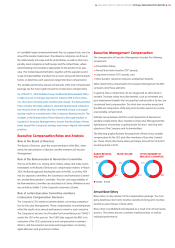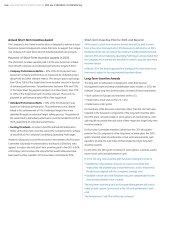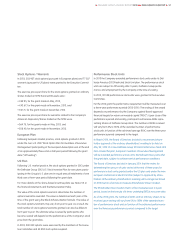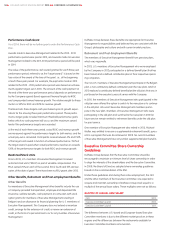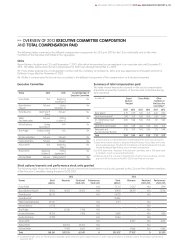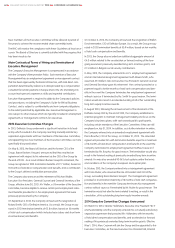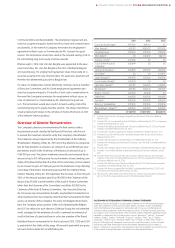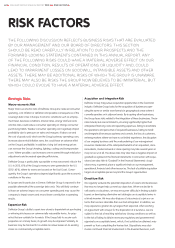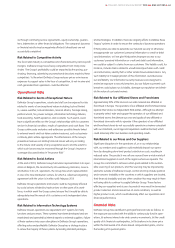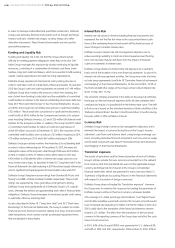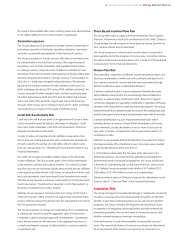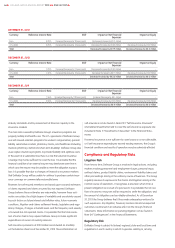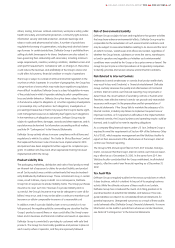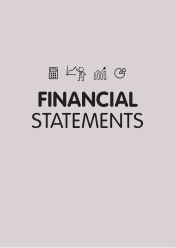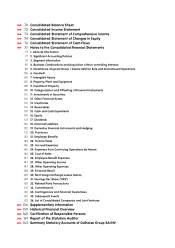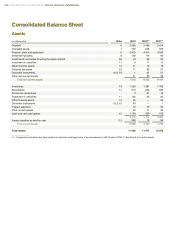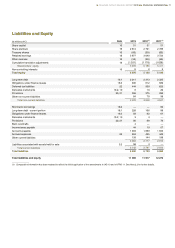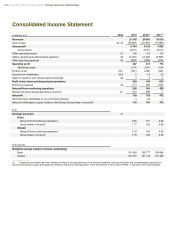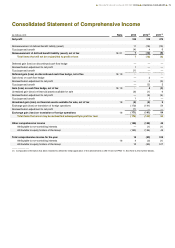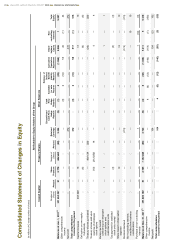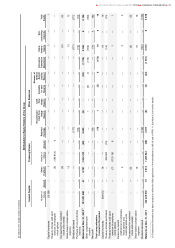Food Lion 2013 Annual Report Download - page 67
Download and view the complete annual report
Please find page 67 of the 2013 Food Lion annual report below. You can navigate through the pages in the report by either clicking on the pages listed below, or by using the keyword search tool below to find specific information within the annual report.
the Group’s financial debt after cross-currency swaps was denominated
in U.S. dollars (65% and 71% in 2012 and 2011, respectively).
Transaction exposure
The Group’s exposure to fluctuations in foreign currency movements in
its business operations is limited as operating companies’ purchases
and sales are primarily denominated in their functional currency.
The Group is exposed to foreign currency risks only on monetary items
not denominated in the functional currency of the respective report-
ing entities, such as trade receivables and payables denominated
in a foreign currency, financial assets classified as available for sale,
derivatives, financial instruments not designated as hedge relationships
and borrowings denominated in a foreign currency. If at December 31,
2013, the U.S. dollar had strengthened/weakened by 14% (estimate
based on the standard deviation of daily volatilities of the Euro/U.S.
dollar exchange rate during 2013 using a 95% confidence interval), the
Group’s net profit (all other variables held constant) would have been
€4 million higher/lower (2012 and 2011: also €4 million higher/lower
with a rate shift of 17% and 22%, respectively). Due to the financing
structure of the Group, such a change in the Euro/U.S. dollar exchange
rate would have no impact on the equity of Delhaize Group.
Credit Risk/Counterparty Risk
Credit risk is the risk that one party to an agreement will cause a finan-
cial loss to another party by failing to discharge its obligation. Credit
risk covers trade receivables, cash and cash equivalents, short term
deposits and derivative instruments.
In order to reduce its counterparty risk, Delhaize Group enters from
time to time into netting agreements with counterparties whereby the
amounts owed by the parties can and will be offset if certain condi-
tions are met (see Note 10.2 “Offsetting of Financial Instruments” in the
Financial Statements).
The credit risk on trade receivables relates mainly to the wholesale
activity in Belgium. The Group covers parts of this risk by entering into
credit insurance policies with external insurers. The contracts contain
stop-loss clauses and maximum liability amounts that provide sufficient
cover against possible annual credit losses. In connection with the cash
and cash equivalents, short term deposits and derivative instruments
Delhaize Group requires a minimum credit quality for its financial invest-
ments (see Notes 11 ”Investments in Securities” and 14 ”Receivables” in
the Financial Statements for further details).
Delhaize Group requires a minimum short term rating of A1/P1 and a
minimum long term rating of A2/A for its deposit and investment trans-
actions. Delhaize Group may deviate from this requirement from time to
time for operational reasons.
The Group’s exposure to changes in credit ratings of its counterparties
is continuously monitored and the aggregate value of transactions
concluded is spread amongst approved counterparties. Counterparty
risk is always assessed with reference to the aggregate exposure to
a single counterparty or group of related parties to avoid or minimize
concentration risk.
Share-Based Incentive Plans Risk
The Group offers various equity-settled incentive plans (Stock Options,
Warrants, Performance Stock Units and Restricted Stock Units). Delhaize
Group hedges the risk arising from those plans by buying, from time to
time, treasury shares and/or derivatives.
The Group’s exposure to share-based incentive plans is reviewed at
least quarterly and at the inception of any new plan. For further informa-
tion about share-based incentive plans, refer to Note 21.3 “Share-Based
Compensation” in the Financial Statements.
Pension Plan Risk
Most operating companies of Delhaize Group have pension plans, the
structures and benefits of which vary with conditions and practices in
the countries concerned. Pension benefits may be provided through
defined contribution plans or defined benefit plans.
A defined contribution plan is a post-employment benefit plan under
which Delhaize Group and/or the associate pays fixed contributions
usually to a separate entity. Under such a plan, there are no legal or
constructive obligations to pay further contributions, regardless of the per-
formance of the funds held to satisfy future benefit payments. The actual
retirement benefits are determined by the value of the contributions paid
and the subsequent performance of investments made with these funds.
A defined benefit plan is a post-employment benefit plan which
normally defines an amount of benefit that an employee will receive
upon retirement, usually dependent on one or more factors such as
age, years of service, compensation and/or guaranteed returns on
contributions made.
Delhaize Group operates defined benefit plans at several of its entities
and approximately 24% of Delhaize Group’s associates were covered
by defined benefit plans at the end of 2013.
If, at the balance sheet date, the fair value of the plan assets of a
defined benefit plan, are lower than the defined benefit obligations
(determined based on actuarial assumptions), the Group would bear
a theoretical ”underfunding risk” at that moment in time. At the end of
2013, Delhaize Group recognized a net liability of €117 million (2012:
€136 million; 2011: €93 million) to cover such underfunding.
Details on pension plans at Delhaize Group and its subsidiaries can be
found in Note 21.1 ”Pension Plans” in the Financial Statements.
Insurance Risk
The Group manages its insurable risk through a combination of external
insurance coverage and self-insured retention programs. In deciding
whether to purchase external insurance or use self-insured retention
programs, the Group considers the frequency and severity of losses,
its experience in mitigating risk through safety and other internal risk
prevention programs, the cost and terms of external insurance, and
whether external insurance coverage is mandatory.
External insurance is used when available at reasonable cost and
terms. The amount and terms of insurance purchased are determined
by an assessment of the Group’s risk exposure, by comparison to
DELHAIZE GROUP ANNUAL REPORT 2013
RISK FACTORS
65


